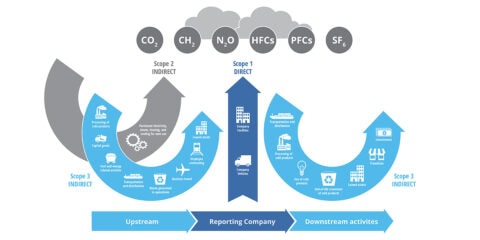Scope 3: What’s All the Fuss About?
In the last couple of weeks, a few things have raised the profile of Scope 3 even higher for us at Sustainable X. The number of our clients focussing in great detail on Scope 3 Carbon emissions and Amazon, releasing their Sustainability Report with the ambition to support their supply chain to decarbonise.
But what exactly is the fuss surrounding Scope 3 and what can businesses practical do?
What Is Scope 3? A Simplified Overview
Think of your company’s carbon footprint as a jigsaw puzzle – a mosaic of emissions that make up your environmental impact. Within this puzzle, Scope 1, Scope 2, and Scope 3 emissions categorise distinct pieces, each revealing a different part of your carbon story.
To simplify,
- Scope 1 encompasses emissions directly stemming from your operations – like burning fuel for heating.
- Scope 2, on the other hand, deals with emissions linked to the electricity you procure.
Scope 3 emissions are a little more complex.
- Scope 3 can be likened to tracing the whole path of carbon left by your products, services, and supply chain. It is not mutually exclusive to other companies!

As an example of how wide the scope 3 net is cast, we recently had a conversation with Charity who has a number of Second-hand clothes shops. Included in their scope 3 Carbon footprint would be the Carbon associated with your donated Levi Demin Jeans, from their manufacture, all the way to their eventual disposal! (Interesting article on the Carbon footprint on Jeans here)
This is a great example of ‘overlap’ of Scope 3 emissions and how the process is designed for everyone to take care of this massive issue!
Scope 3 Categories: A Closer Look
This scope is classified into 15 categories, all of which includes different aspects of a business’s operations and supply chain. From employee travel to the lifecycle of products and the procurement of materials.
These categories encompass a wide range of business activities that contribute to a company’s carbon footprint, extending far beyond the direct operations of your business.

Let’s take a closer look at some of these categories and their significance:
- Purchased Goods and Services: This category focuses on the emissions associated with the goods and services a business procures externally. It sheds light on the carbon footprint of products before they even enter your company’s operations.
- Capital Goods: These are the long-lasting assets a company invests in, like buildings and equipment. The emissions linked to their manufacture, transport, and maintenance form a part of Scope 3.
- Fuel- and Energy-Related Activities Not Included in Scope 1 or 2: This category encompasses the carbon emissions produced by activities like extracting, producing, and transporting the energy sources your company uses, such as oil and natural gas.
- Upstream Transportation and Distribution: The emissions associated with the transportation of goods from suppliers to your company’s doorstep are accounted for in this category.
- Waste Generated in Operations: This includes the carbon footprint attributed to waste disposal, capturing emissions tied to waste management activities.
- Business Travel: Emissions arising from work-related travel – be it air travel, road trips, or train journeys – fall under this category, highlighting the environmental impact of employee mobility.
- Employee Commuting: This category examines the carbon footprint of your employees’ daily commutes to work, considering factors such as distance and mode of transportation.
- Upstream Leased Assets: If your company leases assets like vehicles or equipment, the emissions tied to their production, transportation, and maintenance contribute to your Scope 3 footprint.
- Downstream Transportation and Distribution: Similar to upstream transportation, this category accounts for emissions generated when transporting goods to customers and end-users.
- Processing of Sold Products: If your products undergo processing after sale, such as installation or maintenance, the emissions linked to these activities are included in this category.
- Use of Sold Products: This encompasses the carbon footprint of products during their use by customers, considering factors like energy consumption and emissions during operation.
- End-of-Life Treatment of Sold Products: When products reach the end of their lifespan, the emissions tied to disposal, recycling, or other treatments are accounted for here.
- Downstream Leased Assets: Similar to upstream leased assets, this category includes emissions associated with leased assets, but in the context of customers leasing your products.
- Franchises: If your company operates franchises, the emissions from the operations of these franchises contribute to your Scope 3 emissions.
- Investments: If your company has investments in other ventures, the emissions related to those investments are considered in this category.
Why should businesses care about Scope 3?
It has been reported that Scope 3 emissions can account for a staggering 80-90% of your overall business’ emissions. With the pressure on businesses, mostly large players at the moment, to put plans in place to reduce their carbon emissions, the urgency is being felt by SME’s.
Additionally, there is heightened awareness from stakeholders such as investors, customers, and regulatory bodies, and it leaves no room for ignoring this going forward.
Amazon has just reported in their last Sustainability report, they will focus on tackling Scope 3 in earnest this year, with more reporting expecting of their upstream supply chain and therefore suppliers!
4 reasons to get started
- Business Imperative: As the world moves towards greater sustainability, businesses are under mounting pressure to demonstrate their commitment to reducing environmental impact. Scope 3 emissions are at the centre of this journey.
- Stakeholder Expectations: Investors, customers, and communities are seeking transparency and tangible steps towards reducing carbon footprints. Stakeholders are demanding greater accountability.
- Regulatory Evolution: Regulatory bodies are tightening up on environmental regulations. Many governments are aligning their policies with global climate goals, and Scope 3 emissions are increasingly coming under regulatory scrutiny.
- Competitive Advantage: Businesses that proactively address Scope 3 emissions position themselves as forward-thinking leaders, gaining a competitive edge in an increasingly sustainability-conscious market.

Where to Start?
While it might seem overwhelming – there are some simple steps you can start with.
1. Understanding the Categories most relevant to you and pick 5
In the UK, the most frequently measured Scope 3 emissions, are
- Upstream transportation
- Downstream Transportation
- Waste
- Business travel
- Commuting
2. Identifying a way to measure these
As long as you are transparent about your approach it is OK to use estimation on Scope 3.
The ultimate aim would be to use the actual Carbon emissions generated from these categories, by asking your suppliers. Estimations can be based on Spend, a period of time and an extrapolation or actuals. Government conversion factors exist to support the carbon calculation of your calculations.
3. Start to gather the data
Assemble data related to your products, materials, processes, and travel patterns. Ask your suppliers what date they can provide. Detemine the typical months or cycles that are best to use and start to measure. Use the conversion factors here for your category. https://www.gov.uk/government/publications/greenhouse-gas-reporting-conversion-factors-2023
4. Review the output
When you have some indicative Scope 3 measures for your business. It is important to take 4 things into consideration
- How the data collection can be streamlined
- Where you can make reductions
- How and who you need to report to
- What your suppliers can provide you in the future.
5. Developing your reduction plan and next steps
Ideas for your carbon reduction plan
- Part of the reduction plan can be improving the accuracy of your data collection.
- Consider which categories of Scope 3 you might like to tackle next
- Set targets and ambitions when you have a baseline
- Look into technology that can help you reduce your carbon across these categories
- Work with your suppliers to get more accurate data
- Information and engage your employees on what they can do to move the dial.
- Measure and report your footprint as often as is practical.

Practical Steps to measure the emissions
Business Travel: Calculating emissions
Begin by calculating emissions from business travel – a common source of Scope 3 emissions. For each journey undertaken in the reporting year, record the mode of transport used and the approximate distance covered. Sum up the total distance travelled and then apply the emissions factor specific to each mode of transport. This will enable you to compute the corresponding greenhouse gas emissions accurately. Some businesses capture this in their expense management system.
Employee Commuting: Following a similar approach
Applying a similar methodology, approach employee commuting emissions. Gather data from your employees about the distance they travel to work and the mode of transport they utilise. Multiply this by the number of workdays in the reporting year and factor in the relevant emissions factor, as explained earlier.
Waste Disposal and Treatment: Estimating emissions
Estimating greenhouse gas emissions tied to waste is another critical component. Keep track of the annual waste tonnage produced and identify the treatment method used by your waste management provider for each waste type – such as landfilling, recycling, or incineration. This information might be accessible through your waste bill or by contacting your provider. Multiply the tonnage of each waste type by the emissions factor corresponding to the treatment method to compute emissions accurately.
Upstream Transportation Emissions
Estimating emissions from upstream transportation involves collecting data on the annual tonnage of goods procured, determining the transportation distance for each mode (trucks, ships, trains, airplanes), using emissions factors for each mode, and then calculating emissions by multiplying tonnage with corresponding emissions factors. This process offers insights into the carbon footprint tied to transporting goods from suppliers to your business location, aiding in informed decisions for reducing Scope 3 emissions and enhancing sustainability efforts.
Downstream transportation emissions
Estimating emissions from downstream transportation involves collecting data on product tonnage shipped to customers, determining transportation modes used, calculating delivery distances, applying emissions factors for each mode, and multiplying tonnage by corresponding factors. Which is similar to your upstream approach, but you may have more influence
For details on Categories, measures, and reporting, refer to the GHG protocol.
Finally….
Scope 3 emissions might initially appear to be overwhelming and complicated, but progress is possible…. By unpicking the layers of your carbon footprint and addressing Scope 3 emissions, your business not only reduces environmental impact but also positions itself as a responsible business.